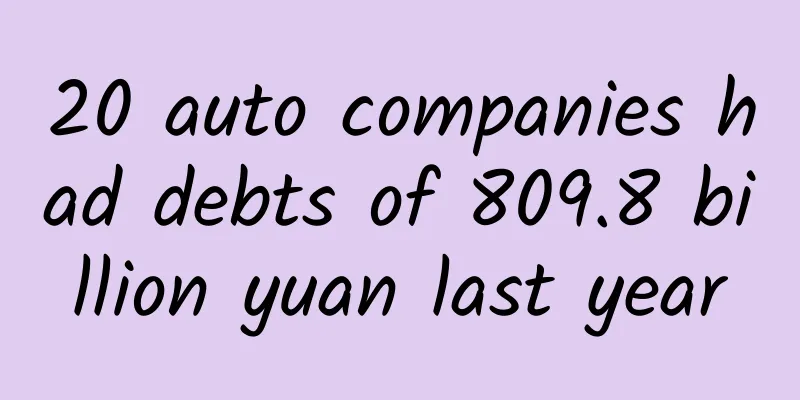20 auto companies had debts of 809.8 billion yuan last year

|
In 2016, my country's automobile production and sales showed rapid growth, with total production and sales reaching 28.119 million and 28.028 million respectively. With the rapid expansion of automobile companies, the scale of automobile companies has also been expanding. At the same time, the debt of automobile companies has also risen sharply. According to statistics from Tonghuashun, the Securities Daily reporter found that 20 automakers had debts of 809.8 billion yuan last year, with an average debt ratio of 63%. Thirteen automakers had asset-liability ratios exceeding 60%, and Ankai Bus and Jinbei Automobile had asset-liability ratios exceeding 80%, reaching 84% and 94% respectively. An analyst told reporters that the vehicle manufacturing industry is a capital-intensive industry with a large amount of capital investment, so reasonable capital allocation has an important impact on its development. The asset-liability ratio of my country's listed auto companies is relatively low compared with developed countries in Europe and the United States. Although it reduces the financial risks of enterprises, it is also not conducive to the effect of financial leverage. In the future, how automakers will adjust their production capacity layout, how to integrate marketing channels, and how to deal with the strong competition from foreign brands are major challenges that Chinese automakers will face. 20 auto companies had debts of 809.8 billion yuan last year According to statistics from 10jqka Securities Daily, as of April 26, the 20 listed auto companies that had released their 2016 annual reports had debts of 809.8 billion yuan, with an average debt ratio of 63%. Specifically, SAIC Group, BYD and Changan Automobile have the highest total debts, which are 355.5 billion yuan, 89.7 billion yuan and 63.2 billion yuan respectively. The debt-to-asset ratios of these three automakers are 60%, 62% and 59%. The three automakers with the highest debt-to-asset ratios are Jinbei Automobile, Ankai Bus and Xiaokang Shares, at 94%, 84% and 77% respectively. Among them, Jinbei Automobile's total liabilities amounted to 10.7 billion yuan. In fact, in 2016, Jinbei Automobile's net profit attributable to shareholders of listed companies was only -208 million yuan, a sharp drop of 683.03% year-on-year. Its asset-liability ratio of 94.% also reached the highest value of Jinbei Automobile since 2010. The reporter observed that although Jinbei Automobile's operating income increased by 160 million yuan in 2016, it still suffered a loss of 200 million yuan. According to its previously released performance forecast, the loss in 2016 was mainly caused by a sharp drop in vehicle sales and losses in its Russian subsidiary. According to the data provided by its consolidated income statement, the main reason for the loss was the increase in operating costs, taxes and surcharges, and financial expenses. According to Jinbei Automobile's annual report, the company's total guarantee amount last year was 3 billion yuan, and the total guarantee amount accounted for 455.05% of the company's net assets. Wang Guihu from the Institute of Economics of the Chinese Academy of Social Sciences said in an interview with the Securities Daily reporter that for listed companies, guarantees are essentially a form of implicit debt, so if the proportion of guarantees to net assets is high, it means that the listed company has a high debt. In addition, data shows that 14 automakers had higher debt scale in 2016 than in 2015. Meanwhile, other automakers with asset-liability ratios exceeding 65% include Dongfeng Motor, Sugon, JAC, Sinotruk and Lifan. Regarding the high debts of auto companies, industry insiders pointed out that in recent years, my country's automobile production and sales have been booming, and the business scale of various auto companies has grown relatively large, resulting in a relatively fast growth in the absolute number of debts. Although the positive auto market has improved the profitability of auto companies, the short-term debt problem is still difficult to solve. SAIC Motor’s debt accounts for 40% It is worth mentioning that in 2016, SAIC Group’s total liabilities reached 355.5 billion yuan, and the liabilities of just one of its companies exceeded 40% of the total liabilities of the 20 companies. The reporter looked through SAIC Group's 2016 annual report and found that the five items that caused the company's high debt were accounts payable of 104.7 billion yuan; advance payments of 22.676 billion yuan; other payables of 45.368 billion yuan; deposits and interbank deposits of 43.146 billion yuan; and non-current liabilities due within one year of 8.674 billion yuan. Regarding SAIC's high debt, a person from the company's securities department explained to reporters: "As the company's car sales continue to increase, the scale of auto sales loans is also gradually expanding, which is mainly reflected in the substantial growth of accounts receivable, and the resulting financial collection risks are also increasing accordingly. Company managers must attach great importance to this, strengthen the management of accounts receivable, and speed up the collection of accounts receivable." The reporter noted that the company's assets and liabilities exceeded 100 billion yuan for the first time in 2010, reaching 147.094 billion yuan. By 2015, the total liabilities had increased to 300.713 billion yuan. Regarding the growth of SAIC's debt, the above-mentioned person said that rapid expansion is an important driver of the company's high debt, and SAIC's rapid development is also inseparable from the help of debt. Overall, the company's capital structure tends to be stable and reasonable, its debt repayment ability is guaranteed, and the overall debt repayment risk is not high. It is generally believed in the industry that in recent years, while strengthening cooperation with internationally renowned automakers, SAIC has also continuously improved the R&D and production of its own brands, and has invested a lot of manpower, material and financial resources in production lines, R&D departments, sales channels and other fields. The next step should be to strengthen inventory management, improve the return on total assets and strengthen the management of accounts receivable, accurately grasp the rhythm of production and sales, and vigorously improve the structure and efficiency of operations. As a winner of Toutiao's Qingyun Plan and Baijiahao's Bai+ Plan, the 2019 Baidu Digital Author of the Year, the Baijiahao's Most Popular Author in the Technology Field, the 2019 Sogou Technology and Culture Author, and the 2021 Baijiahao Quarterly Influential Creator, he has won many awards, including the 2013 Sohu Best Industry Media Person, the 2015 China New Media Entrepreneurship Competition Beijing Third Place, the 2015 Guangmang Experience Award, the 2015 China New Media Entrepreneurship Competition Finals Third Place, and the 2018 Baidu Dynamic Annual Powerful Celebrity. |
Recommend
Did you know? After HIV infection, you actually have 72 hours to save yourself
today The 34th World AIDS Day...
University of Mainz, Germany: Study finds link between soil pollution and heart disease
Pesticides and heavy metals in soil may have adve...
How to transfer files without network in Android
A recent project required the implementation of a...
The most comprehensive guide to short video distribution on Tik Tok, Kuaishou, etc.!
In the Internet age, short videos are king. 2018 ...
Learning skateboarding from scratch - from beginners to fancy tricks
Learning Skateboarding from Scratch - Introductio...
For an Internet finance platform, is a 30% increase in the number of users each month considered "growth"?
What is growth? Any growth that is not aimed at i...
How are planets in the universe "eaten" by black holes? Where will they go in the end?
Black holes can be regarded as the top celestial ...
Online Bootcamp Operation Manual (SOP)
As we all know, training camps have become the mo...
Nanchang SEO Training: How to write a high-quality SEO article? What aspects can be improved?
Many webmasters believe that the website content ...
Survey on the employment dilemma of IT enterprises in the "Internet +" era
The concept of "Internet +" has spawned...
Cross-border B brother-tiktok advertising quick start course
A comprehensive explanation of the practical oper...
Chinese scientists discovered the world's first alpine meteorite crater! Why are there no traces of meteorites in the crater?
According to Xinhua News Agency and other media r...
Is it difficult to convert users into promotion? Catering to the fun point is the key
With the development of information flow advertis...
Bidding customer service skills Bidding customer service tutorial Bidding customer service skills Conquer marketing customer service skills tutorial
The following is a description of the bidding cus...









